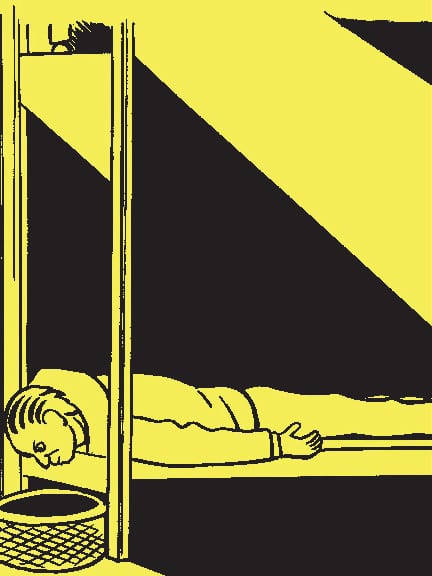Facades make good doctors. Like the fences that make good neighbors. If a patient happens to see behind a doctor’s facade, all bets are off. In Dash Shaw’s latest graphic novel, Doctors, we are given a glimpse behind one such facade into a pretty unusual medical practice.
Set in the future, the story is about a wealthy woman, Mrs. Bell, who slips at a public swimming pool, hits her head, and dies. As the narrative unfolds, we discover that upon her death, Mrs. Bell’s corpse has been displaced from the conventional morgue and brought by two so-called doctors—Dr. Cho and his daughter Tammy—to a creepy Brooklyn basement where, with the help of an assistant named Will, they attempt to head off Bell’s spirit in the afterlife and convince it to return to life.
The doctors claim to be rescuing Mrs. Bell before her post-death “fade to blackness,” but it takes quite a lot of deception and coercion to pry her away from her fairly cushy stay in the afterlife.
Meanwhile, we sense that business is not going so well for Dr. Cho’s pioneering practice. The finicky machine they use to enter the afterlife is an aging dust-covered computer, outfitted with equipment vaguely reminiscent of vintage electroshock therapy. At one point, Dr. Cho blows the dust off the tangled wires in his computer’s hard-drive to get it going again—a wink at the classic dystopian sci-fi world run by obsolete machinery from all eras. Fearlessly, Tammy lays down on her back, side by side with the corpse of Mrs. Bell, allowing her living brain to be hooked by cables to the dead brain of the corpse—the connection creates a portal between life and death. And this is how the therapy is administered.
“The first step,” says Cho encountering her patient in the afterlife, “is to acknowledge that you’re dead and need help.” Some of us know this line all too well. Tammy then tells Mrs. Bell: “if you sync your body to our treatment and strive to receive our help, we may be able to get you to a state we can work from…” Um…no thanks.
If trust is crucial to the patient-doctor dynamic, then the Cho team has already blown it. And yet, trust is also important in the author-reader dynamic—and hooked as we are by Shaw’s carefully constructed story, we are all in for the compelling work of science fiction that lies ahead.
The father-sibling relationship is, in fact, also very believable. Shaw uses flashbacks to add depth and motive to characters, making them feel vulnerable and human. With quick breaks in the narrative, segments of backstory are injected that quickly nourish what is next to come.
We discover that Tammy and her father have lost their mother/wife. Insert flashback: she was murdered. Gulp. We learn that it is grief and denial that propel this father and daughter forward in their search into the afterlife. But Tammy has grown skeptical. She reasons with her father that the few people they have brought back have become very depressed by the prospect of having to live again—all of the patients have committed suicide, in just a few weeks. In one beautiful page we see a distant blurry ink mark half way down between the silhouetted Manhattan Bridge and the moon-lit East River. It is a wonderfully lonely image of a jumper witnessed from afar.
As clinical as they strive to be, the doctors cannot maintain a professional ethical facade—we see the madness of Cho’s mad-scientist emerge. And yet, instead of possessing the mania of a man too passionate for his own good, Dr. Cho seems more like the average, uninspired business owner. Tammy wants him to admit to himself that his work is having a negative effect on their clients. “We’re playing with people’s lives,” she says. Playing with peoples deaths, would be more accurate.
The Cho duo doesn’t exactly inspire confidence. Most memorable is a scene where Drs. Cho and Tammy are boarding an airplane. The father discusses how he always gets drunk when he flies so that he will not be expected to come to anyone’s aid as a medical professional. It is perhaps his most vulgar admission of un-doctorly values: “but if a doctor is called to help someone on a plane, they usually miss their next flight, and the airline doesn’t even reimburse their first flight…. That is why I start drinking wine as soon as I board a plane. Most doctors do.”
Shaw’s drawings and plot are vague and specific at the same time. He leaves out details, keeping the reader dangling on the verge of confusion, which can make the book a little challenging the first time through. But often the disorientation allows for certain images to feel all the more accurate and striking. Details repeatedly emerge in full focus and with stunning conviction. In one scene a woken client wanders around observing the world one last time and glimpses a butterfly perched atop the bent straw poking through the plastic-lid of a paper cup. It’s a Dash Shaw moment.
Shaw’s Doctors perform on patients (dead as they may be) who are then left in limbo, feeling desperate and suicidal. But what he is really getting at, however, is the current desperation, not of the patient, but of the doctor. Being a doctor is no longer a secure business to go into, and the most qualified would-be doctors are choosing other fields, leaving medicine wide open to inferior untrained crackpot quacks—grotesque entrepreneurs in white lab coats. Last time I went to my Doctor, her newborn baby was in the examination room with us cause she couldn’t afford daycare.
Ordinarily, the living are haunted by ghosts. But in this story, ghosts are being haunted by the living. Clever.










